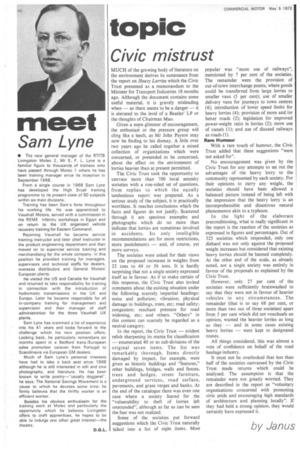topic
Page 42

If you've noticed an error in this article please click here to report it so we can fix it.
Civic mistrust
MUCH of the growing body of literature on the environment derives its sustenance from the report on Heavy Lorries which the Civic Trust presented as a memorandum to the Minister for Transport Industries 18 months ago. Although the document contains some useful material, it is gravely misleading when — as there seems to be a danger — it is elevated to the level of a Beatles' LP or the thoughts of Chairman Mao.
Given a mere glimmer of encouragement, the enthusiast or the pressure group will cling like a leech, as Mr John Peyton may now be finding to his dismay. A little over two years ago he called together a mixed collection of organizations which were concerned, or pretended to be concerned, about the effect on the environment of lorries heavier than at present permitted.
The Civic Trust took the opportunity to canvass more than 700 local amenity societies with a one-sided set of questions, from replies to which the equally tendentious report was prepared. As a serious study of the subject, it is practically worthless. It reaches conclusions which the facts and figures do not justify. Scattered through it are specious examples and photographs which do no more than indicate that lorries are sometimes involved in accidents. Its only intelligible recommendations are for more restrictions, more punishments — and, of course, yet more surveys.
The societies were asked for their views on the proposed increases in weights from 32 tons to 44 or 56 tons. It is hardly surprising that not a single society expressed itself as in favour. As if to make certain of this response, the Civic Trust also invited comments about the existing situation under the following scarcely impartial headings: noise and pollution; vibration; physical damage to buildings, trees, etc; road safety; congestion; resultant pressure for road widening, etc; and others. "Others" in this context can scarcely be regarded as a neutral category.
In the report, the Civic Trust — evident relish sharpening its mania for classification — enumerated 40 or so sub-divisions of the original seven items. The list was remarkably thorough. Items directly damaged by impact. for example, were given as historic buildings and "features," other buildings, bridges, walls and fences, trees and hedges, street furniture, underground services, road surface, pavements, and grass verges and banks. At the end of the catalogue there was even one case where a society feared for the "vulnerability to theft of lorries left unattended", although as far as can be seen the fear was not realized.
Some of the societies put forward suggestions which the Civic Trust naturally tidied into a list of eight items. Most popular was "more use of railways", mentioned by 7 per cent of the societies. The remainder were the provision of out-of-town interchange points, where goods could be transferred from large lorries to smaller vans (5 per cent); use of smaller delivery vans for journeys to town centres (4); introduction of lower speed limits for heavy lorries (4); provision of more and/or better roads (2); legislation for improved power-weight ratio in lorries (2); more use of canals (1); and use of disused railways as roads (1).
Rare Humour
With a rare touch of humour, the Civic Trust added that these suggestions "were not asked for".
No encouragement was given by the Civic Trust for any attempts to set out the advantages of the heavy lorry to the community represented by each society. For their opinions to earry any weight, the societies should have been allowed a balanced picture instead of being left with the impression that the heavy lorry is an incomprehensible and disastrous natural phenomenon akin to a typhoon.
In the light of the elaborate preconditioning, what is really significant in the report is the reaction of the societies as expressed in figures and percentages. Out of 325 societies which responded, only one diehard was not only against the proposed weight increases but considered that existing heavy lorries should be banned completely. At the other end of the scale, as already noted, not a single society was entirely in favour of the proposals as explained by the Civic Trust.
However, only 27 per cent of the societies were sufficiently brainwashed to say that they were not in favour of heavier vehicles in any circumstances. The remainder (that is to say 68 per cent, or more than two out of three societies) apart from 5 per cent which did not vouchsafe an opinion, wanted the heavier lorries as long as they — and in some cases existing heavy lorries — were kept to designated routes.
All things considered, this was almost a vote of confidence on behalf of the road haulage industry.
It must not be overlooked that less than half of the societies canvassed by the Civic Trust made returns which could be analysed. The assumption is that the remainder were not greatly worried. They are described in the report as "voluntary organizations concerned with promoting civic pride and encouraging high standards of architecture and planning locally". If they had held a strong opinion, they would certainly have expressed it.
by Janus




























































































